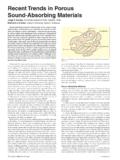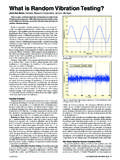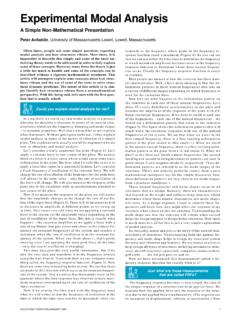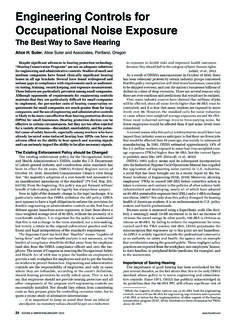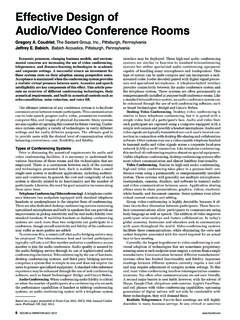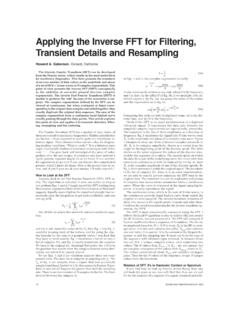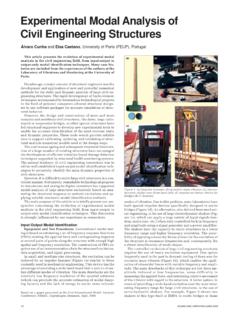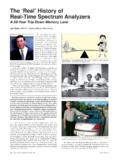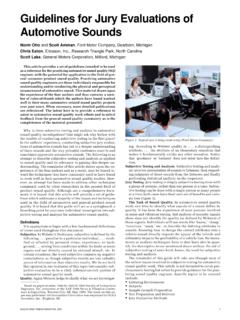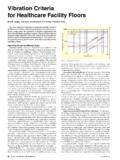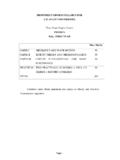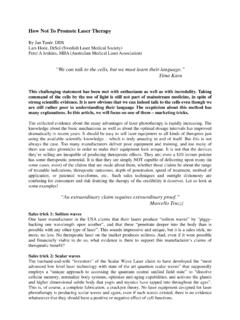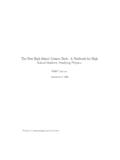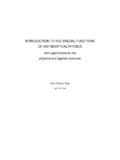Transcription of The PU Mini Probe – A Multipurpose Acoustics Sensor
1 DYNAMIC TESTING REFERENCE ISSUE 17 The PU mini Probe A Multipurpose Acoustics SensorSensors for Acoustics are usually based on the measurement of sound pressure at the diaphragm of the transducer. Another means of describing a sound field, the vector value acoustic par-ticle velocity, is only directly measurable with Microflown PU probes . These MEMS technology-based transducers utilize two very thin, heated, platinum wires as a particle velocity Sensor and a microphone as a sound pressure Microflown PU mini Probe for vibroacoustic testing pro-vides new capabilities for industry from product development to production quality control. The transducer shown in Figure 1 measures both sound pressure and acoustic particle velocity at one point.
2 In 2009, a new version of the Probe was developed in close cooperation with a well known test lab and a car manufacturer, both located in the UK. Goals for the redesign included flexibility and the ability to handle near-field applications such as panel noise contribution analysis, scan and listen, near-field acoustic camera and more. The new PU mini and accessories are well suited for specific acoustic measurements on cars, aircraft, trains, helicopters and space PrincipleAny sound field can be described completely by knowing the following dimensions:Scalar sound pressure acoustic particle velocity vector If sound pressure is the acoustical equivalent of voltage, acoustic particle velocity is the acoustical equivalent of current. Based on MEMS (Micro Electro Mechanical Systems) technology, the Mi-croflown Sensor working principle uses two extremely sensitive heated platinum wires that have very little thermal resistance (see Figure 2).
3 If air flow occurs around these wires, heat transfer will take place, causing the upstream wire to be cooled and the air flow to be heated. As a consequence, the downstream wire is cooled just a bit less. The temperature difference that takes place in the sensing region happens to be a direct measurement of the acoustic particle velocity. The Sensor voltage output is influence of background noise and reflections when using Microflown sensors in the near field is very low. This can be ex-plained by three main effects: directionality of particle velocity; incoming sound waves to a surface low surface particle velocity and high surface pressure; and outgoing sound waves from the surface of a sound source high surface particle velocity and low surface of Particle Velocity.
4 A sound pressure microphone is omnidirectional and measures the sound field in all directions. A PU mini measures the particle velocity in one direction. Therefore in a diffuse sound field, a PU mini picks up only one third of the sound field, while a pressure microphone measures the total sound Sound Waves to a Surface. Concerning back-ground noise, the sound pres-sure level and particle velocity level are of similar magnitude in the free field. If the sound waves are reflected by a rigid surface, the sound pressure doubles and the particle velocity reduces to zero. Therefore the particle velocity component of the background noise at the surface is often negligible, ensuring that the test object itself is indeed Sound Waves from Surface.
5 At the surface of a test object close to a vibrating (sound-emitting) surface, the sound pressure level is still low as compared to the particle velocity level that coincides with the structural , to identify a sound source in the acoustic near field, measuring the acoustic particle velocity rather than the sound pressure alone has some distinct Intensity MeasurementAccording to the mathematics, sound intensity is simply the product of the sound pressure and acoustic particle velocity. The Microflown PU mini is the world s only Sensor directly measur-ing acoustic particle velocity, so it provides a new approach for measuring sound intensity. PU probes are broad-band transducers (20 Hz-20 kHz) and don t require spacers between sensors.
6 The small size of the Sensor allows testing on small objects with high spatial resolution such as computer hard drives or cell phones. Furthermore, PU probes can be used outside of an anechoic room or in reverberant conditions. The Sensor is not affected by situa-tions where there is a high sound pressure over intensity ratio. This allows sound intensity measurements on large structures, such as the turbo machinery shown in Figure 3, that cannot be tested in an anechoic room for obvious and ListenA unique single Probe testing method is known as scan and listen. acoustic particle velocity can be made audible when a PU mini is equipped with a headset, as shown in Figure 4. For ex-ample, it allows for the analysis of nonstationary problems or even transients like squeak and rattle.
7 Human ears are like traditional microphones that are sensitive to scalar omnidirectional sound pressure. A combination of a Microflown PU mini with scan-and-listen hardware allows our ears to be capable of listening to particle velocity! You can really listen to what nobody has heard before. Locating sound sources in actual environments can be difficult. Just listening to particle velocity may provide better results than extensive, detailed FFT analysis. Performing quick scans instead of a time-consuming series of measurements is an intuitive method for sound source location. acoustic leakages can be detected quickly Andrea Grosso and Jeroen Verbeek, Microflown Technologies, Zevenaar, The NetherlandsFigure 1. Redesigned PU mini Probe with clickable LEMO 2.
8 Working principle of the MEMS Microflown SOUND & VIBRATION/SEPTEMBER 2010and accurately with the system. The system also has the option to simultaneously record while & PaintThe PU mini can be used in conjunction with a webcam to merge acoustic and video data. Scan & Paint is a new tool to vi-sualize stationary sound fields. Scan & Paint offers a fast method to visualize sound fields over a broad frequency range and can be used in environments with a high level of background noise or lots of practice, there are many cases where ideal acoustical condi-tions are not available, such as in an engine bay or car interior, as shown in Figure 5. To assess sound quality in terms of radiated sound intensity, a very large number of measurement points is often required.
9 A quick method is now available where the position of the Probe is filmed while recording the sound. With synchronization of the sound and position data, a powerful tool can now be used to assess large surfaces in reverberant conditions. Outdoor mea-surements are also possible (see Figure 6). Furthermore, the same technique can be used for the in-situ acoustic testing of materials. Scanning the surface with the in-situ absorption setup using scan-and-paint technology will provide high-resolution visualization of surfaces in terms of impedance, absorption and Absorption MeasurementsThe PU mini can assess the acoustical properties of sound absorption materials (see Figures 7 and 8). The PU mini -based in situ absorption method is a promising new technique.
10 A PU mini combined with a well defined spherical loudspeaker can test materials nondestructively. As impedance measurements are relative, the loudspeaker can be calibrated independently before measuring with the sound source close to the tested material. The sound pressure and acoustic particle velocity are measured right at the surface of the material. The impedance can be derived from the ratio of sound pressure and particle velocity. From this, the mate-rial reflection and absorption can be calculated. See the following formulas for impedance, reflection and absorption:where:Z = acoustic impedance, N-sec/m3P = sound pressure, N/m2u = particle velocity, m/secr = air density, kg/m3c = sound velocity, m/secR = sound reflection coefficient (ratio)a = sound absorption coefficient (ratio)Zpu=RZcZc=-+rra=-12 RFigure 3.
